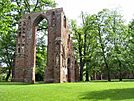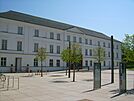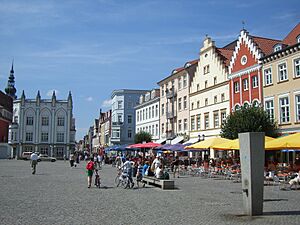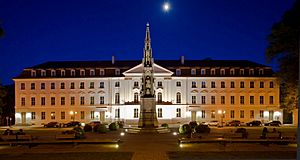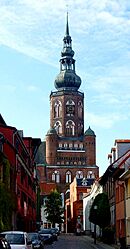Greifswald facts for kids
Quick facts for kids
Greifswald
|
|||
|---|---|---|---|
|
Clockwise from top: town hall and St Nicholas' Church, Pomeranian State Museum, drawbridge over the Ryck, view of the city with St Mary's, St Nicholas' and St James', new harbour and Holzteichquartier (woodpond borough), ruins of Eldena (Hilda) Abbey
|
|||
|
|||
| Country | Germany | ||
| State | Mecklenburg-Vorpommern | ||
| District | Vorpommern-Greifswald | ||
| Elevation | 5 m (16 ft) | ||
| Population
(2022-12-31)
|
|||
| • Total | 59,691 | ||
| Time zone | CET/CEST (UTC+1/+2) | ||
| Postal codes |
17489-17493
|
||
| Dialling codes | 03834 | ||
| Vehicle registration | HGW | ||
| Website | www.greifswald.de | ||
Greifswald is a city in northeastern Germany. Its full official name is the University and Hanseatic City of Greifswald. It is the fourth-largest city in the German state of Mecklenburg-Western Pomerania. Greifswald is located on the Ryck River, which flows into the Baltic Sea.
The city's name comes from the Griffin, a mythical creature that is also the symbol of the dukes who once ruled the area. So, Greifswald means "Griffin's Forest."
Greifswald is home to the University of Greifswald, founded in 1456. This makes it one of the oldest universities in the Baltic Region. The city is also famous for the ruins of Eldena Abbey, which was painted by the famous artist Caspar David Friedrich, who was born here. The Pomeranian State Museum is also located in Greifswald.
In 2021, Greifswald had a population of over 59,000 people. This includes many of the university's 12,500 students and 5,000 employees. The city is known for its university, its growing biotechnology industry (BioCon Valley), and important energy projects like the Nord Stream 1 gas pipeline.
Contents
Exploring Greifswald's Location
Greifswald is in the northeast of Germany. It's about halfway between Germany's two largest islands, Rügen and Usedom. The city center is about 5 kilometers (3 miles) up the Ryck River from the Bay of Greifswald. The land around Greifswald is mostly flat.
Two islands, Koos and Riems, are also part of Greifswald. You can reach three of Germany's national parks within an hour by car from the city. Greifswald is also roughly 240 kilometers (150 miles) from Berlin and 260 kilometers (160 miles) from Hamburg.
The part of Greifswald by the sea, called Greifswald-Wieck, used to be a fishing village. Today, it has a small beach, a marina, and the city's main port.
Greifswald's Weather
Greifswald has a mild climate, influenced by the ocean. Summers are pleasantly warm, but nights can be cool. Because it's near the coast, very hot weather is less common here than in places further inland. Winters are mild to cold. It rains fairly evenly throughout the year, but the total rainfall is low compared to other parts of Germany. Greifswald also gets more sunshine than the average German city.
Greifswald's Past
How Greifswald Began
Greifswald was founded in 1199 by Cistercian monks. They built Eldena Abbey near the mouth of the Ryck River. In 1250, Wartislaw III, Duke of Pomerania, officially made Greifswald a town, giving it special rights under the Lübeck law.
The area where Greifswald now stands was once a forest. It was a border area between Danish and Pomeranian lands. The monks built their abbey near a natural salt pond, which was also close to an important trade route. This place was called Gryp(he)swold(e), which means "Griffin's Forest." A legend says a griffin showed the monks where to build the town.
The town was built with straight, rectangular streets, with the church and market in the center. People from different places, including Germans and local Wends, came to live there.
The salt trade helped Eldena Abbey become very important. Greifswald grew into a well-known market town. When the Danes lost control of their lands south of the Ryck River in 1227, Greifswald became part of the Pomeranian dukes' territory.
In 1241, both the Rugian prince and the Pomeranian duke gave Greifswald market rights. Later, in 1250, the town received its official town charter.
Growth and Changes in the Middle Ages
When a Franciscan monastery was built inside Greifswald's walls, Eldena Abbey's influence on the city lessened. A new area called Neustadt (New Town) grew up next to Greifswald. In 1264, Neustadt joined with Greifswald.
Many important buildings in Greifswald, including Eldena Abbey, were built in the Brick Gothic style. This style uses bricks and is common along the southern coast of the Baltic Sea.
Greifswald grew steadily and became one of the first cities to join the Hanseatic League. This group of trading cities helped Greifswald become even richer and more powerful. By 1296, the citizens of Greifswald no longer had to serve in the Pomeranian army.
In 1456, Heinrich Rubenow, the mayor of Greifswald, helped start the University of Greifswald. It is one of the oldest universities in the world and was one of the first in Germany.
During the Protestant Reformation, Eldena Abbey stopped being a monastery. Its lands went to the Pomeranian dukes, and its bricks were used for other buildings. The abbey was later absorbed into Greifswald. The other monasteries in the city were also closed. The buildings of the Dominicans became part of the university, and the Franciscan monastery is now the Pomeranian State Museum.
During the Thirty Years' War (1618–1648), Greifswald was taken over by Imperial forces from 1627 to 1631. Then, Swedish forces took control in 1631 and stayed.
Swedish Rule (1631–1815)
After the Thirty Years' War, Greifswald and the area around it became part of Sweden. This region was called Swedish Pomerania. It remained Swedish until 1815, when it became part of Prussia. Later, in 1871, it became part of Germany.
The Thirty Years' War caused a lot of hardship. By 1630, Greifswald's population had shrunk by two-thirds, and many buildings were empty. Other wars followed, and Greifswald was bombed in 1659 and 1678. Cannonballs from the 1678 bombing can still be seen in the walls of St Mary's Church.
During the Great Northern War (1700–1721), Greifswald had to house soldiers. In 1713 and 1736, large fires destroyed many houses and buildings, including the City Hall. To encourage rebuilding, the Swedish government offered tax breaks to people who built or rebuilt houses.
In 1763, the Greifswald Botanic Garden was founded.
Greifswald in Modern Germany

In the 19th century, Greifswald began to grow beyond its old city walls for the first time since the Middle Ages. A major railway line connected Greifswald to Stralsund and Berlin.
Greifswald survived World War II without much damage. In April 1945, a German Army officer, Rudolf Petershagen, decided to surrender the city to the Red Army without a fight. This saved Greifswald from destruction.
From 1949 to 1990, Greifswald was part of East Germany (the German Democratic Republic). During this time, many historic buildings were neglected. The city's population grew a lot because a large nuclear power plant was built nearby in Lubmin. New neighborhoods with large apartment blocks were built to house the growing population.
After 1990, when Germany was reunified, work began to restore the old town. Most of it has now been beautifully rebuilt. The historic marketplace is considered one of the most beautiful in northern Germany. Greifswald attracts many tourists, partly because it is close to the Baltic Sea.
Greifswald's population reached its highest point in 1988 with about 68,000 people. It then decreased but has now become stable around 55,000. The number of students at the university has grown a lot, and the university employs many people. This means that nearly one in three people in Greifswald are connected to higher education.
Even though it's a smaller city, Greifswald is important because of its university and its role in the region. It is home to the bishop of the Pomeranian Lutheran Church, the state archives, and the Pomeranian Museum. Several important courts for the state of Mecklenburg-Vorpommern are also located here.
Greifswald's Economy
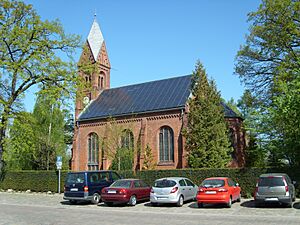
The University of Greifswald is very important to the city's economy, with its 12,000 students and nearly 5,000 employees. Many people also work at research centers like the Friedrich Loeffler Institute.
Tourism is also a big part of Greifswald's economy. The city is located between the popular islands of Rügen and Usedom on the German Baltic coast, which attracts many visitors.
Greifswald is home to HanseYachts, one of the world's largest makers of yachts. In the energy field, the Nord Stream 1 natural gas pipeline from Russia to Germany ends nearby in Lubmin. Riemser Arzneimittel is a pharmaceutical company located on the island of Riems, which is part of Greifswald.
In a 2008 study, Greifswald was named Germany's most dynamic city. Another study in 2008 called it the "youngest city" in Germany because it has the highest percentage of households led by people under 30.
Greifswald's Sister Cities
Greifswald has special partnerships with other cities around the world. These are called "sister cities" or "twin towns." They help promote friendship and understanding between different cultures.
 Goleniów, Poland (since 2006)
Goleniów, Poland (since 2006) Hamar, Norway (since 1997)
Hamar, Norway (since 1997) Kotka, Finland (since 1959)
Kotka, Finland (since 1959) Lund, Sweden (since 1990)
Lund, Sweden (since 1990) Newport News, United States (since 2007)
Newport News, United States (since 2007) Osnabrück, Germany (since 1988)
Osnabrück, Germany (since 1988) Szczecin, Poland (since 2010)
Szczecin, Poland (since 2010)
Greifswald also has friendly relations with these cities:
 Benxi, China
Benxi, China Bryan, United States (since 1995)
Bryan, United States (since 1995) College Station, United States (since 1995)
College Station, United States (since 1995) Drohobych, Ukraine (since 2017)
Drohobych, Ukraine (since 2017) Pomerode, Brazil (since 2005)
Pomerode, Brazil (since 2005) Samos, Greece (since 2015)
Samos, Greece (since 2015) Shenyang, China
Shenyang, China Tartu, Estonia (since 2006)
Tartu, Estonia (since 2006) Vyborg, Russia (since 2018)
Vyborg, Russia (since 2018)
Learning and Culture in Greifswald
The University of Greifswald
The University of Greifswald, founded in 1456, is one of the oldest universities in both Germany and Europe. About 12,300 students study here in five main areas: theology, law/economics, medicine, humanities/social sciences, and mathematics/natural sciences.
The university works with many research centers, including:
- The Max-Planck-Institut für Plasmaphysik, which studies plasma physics and experiments with a special device called Wendelstein 7-X.
- The Friedrich Loeffler Institute on the Isle of Riems, which is a national research institute for animal health.
Schools in Greifswald
Greifswald has several secondary schools, including:
- Alexander-von-Humboldt-Gymnasium
- Friedrich-Ludwig-Jahn-Gymnasium (founded in 1561, one of Germany's oldest schools)
- Ostseegymnasium
Museums and Events
Greifswald has several museums and exhibitions. The most famous is the Pomeranian State Museum (Pommersches Landesmuseum). It shows the history of Pomerania and has art, including paintings by Caspar David Friedrich, who was born in Greifswald. The University of Greifswald also has many collections, some of which are open to the public.
Fun events and attractions in Greifswald include:
- Theater Vorpommern: a theater that hosts plays, orchestra concerts, and operas.
- Nordischer Klang: the largest festival of Nordic culture outside of the Nordic countries.
- Eldena Jazz Evenings: jazz concerts held at the Eldena Abbey ruins.
- Gaffelrigg summer fair: a lively summer festival.
- Museumshafen: a "museum port" with historic ships.
- Greifswald International Students Festival (GrIStuF e. V.): a festival organized by students.
Cinemas
For movie lovers, the film club "Casablanca" regularly shows art house films. The Koeppenhaus also has special film programs. There's even a unique cinema initiative called "KinoAufSegeln" that shows outdoor art house movies at the Greifswald shipyard museum.
Places to See in Greifswald
Old Churches
Greifswald has beautiful churches built in the brick gothic style.
- The Dom St. Nikolai (St. Nicholas collegiate church) is in the city center. Its 100-meter (328-foot) tall tower is a symbol of Greifswald. The original church was built in the late 13th century.
- The St.-Marien-Kirche (St. Mary's Church) was built next to the Old Town marketplace in the mid-13th century. It has very thick brick walls. Inside, you can see medieval paintings that were restored in the 1970s and 80s.
- On the west side of the Old Town is the St.-Jacobi-Kirche (St. James's Church), built in the early 13th century. Its tower was rebuilt with bricks after a fire in 1955.
Stolpersteine Memorials
Around Greifswald, you can find Stolpersteine (stumbling stones). These are small brass plaques placed in the sidewalk in front of houses. Each plaque is engraved with the name of a Jewish person who lived there and was harmed during the Holocaust. These memorials remind us of the terrible events of the past.
Some Stolpersteine in Greifswald mark the events of November 9, 1938, known as Kristallnacht. On this night, many Jewish people were attacked, Jewish property was destroyed, and synagogues were burned down, including the Greifswald Synagogue, which dated back to 1787. In 2012, all 13 Stolpersteine in Greifswald were stolen, but they were replaced the following year.
In 2008, a memorial plaque was placed at the site of the synagogue. The German Chancellor, Angela Merkel, attended the ceremony.
Getting Around Greifswald
Greifswald is a very bike-friendly city. In 2009, a study showed that 44% of people in Greifswald used their bicycles for daily travel, which was the highest rate in Germany at the time. There are also local and regional buses.
Greifswald is about 250 kilometers (155 miles) from Germany's two largest cities, Berlin and Hamburg. You can reach them by car using the Autobahn 20 in about two hours. There are also train connections to Hamburg (through Stralsund and Rostock) and Berlin. The popular islands of Usedom and Rügen are easy to reach by car or train.
Greifswald railway station connects the city to other places like Stralsund, Berlin, and Szczecin. You can also take high-speed ICE and EuroCity trains from here.
Greifswald has a port on the Baltic Sea and several marinas. The historic city center is about 3 kilometers (1.8 miles) from the coast. You can reach it by yacht or small boat on the Ryck River. The Bay of Greifswald is a popular spot for sailing and surfing.
Famous People from Greifswald

Many notable people have come from Greifswald, including artists, writers, and athletes.
- Caspar David Friedrich (1774–1840), a very famous Romantic painter.
- Edmund Hoefer (1819–1882), a novelist and literary critic.
- Elisabeth of Wied (1843–1916), who became the first queen of Romania.
- Hans Fallada (1893–1947), a well-known author.
- Wolfgang Koeppen (1906–1996), another important author.
- Doris Gercke (born 1937), a writer of popular crime thrillers.
- Joachim Dreifke (born 1952), a rower who won medals in the Olympics.
- Caren Metschuck (born 1963), a swimmer who won a gold medal at the 1980 Olympics.
- Robin Szolkowy (born 1979), a figure skater who won two Olympic bronze medals.
- Toni Kroos (born 1990), a famous former footballer for Real Madrid and the German national team.
See also
 In Spanish: Greifswald para niños
In Spanish: Greifswald para niños



